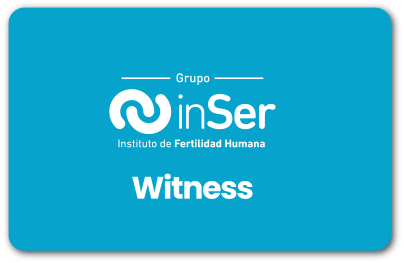
Your security is
our priority
RI Witness™ User Identity Dual Verification System

Your security is
our priority
RI Witness™ User Identity Dual Verification System
RI Witness™ User Identity Dual Verification System
The RI Witness™ system it is a system of identification and traceability of patient samples that ensures that clinical and laboratory procedures in
which there is extraction, manipulation or transfer
of reproductive material (ovules, sperm and/or
embryos) is performed safely, through an electronic and automatic identification that supports
embryologists in their daily work, avoiding errors
through the testimonial tracking of the samples in
the laboratory
What does this mean to you?
It allows you to have the confidence that your
samples are electronically tracked throughout
your reproductive treatment cycle (in vitro fertilization / gamete and embryo cryopreservation /
intrauterine inseminations) avoiding sample identification confusion.

RI Witness™ User Identity Dual Verification System
The RI Witness™ system it is a system of identification and traceability of patient samples that ensures that clinical and laboratory procedures in
which there is extraction, manipulation or transfer
of reproductive material (ovules, sperm and/or
embryos) is performed safely, through an electronic and automatic identification that supports
embryologists in their daily work, avoiding errors
through the testimonial tracking of the samples in
the laboratory.
What does this mean to you?
It allows you to have the confidence that your
samples are electronically tracked throughout
your reproductive treatment cycle (in vitro fertilization / gamete and embryo cryopreservation /
intrauterine inseminations) avoiding sample identification confusion.
How does RI Witness™ work?
1.

Card Assignment:
Each patient is assigned a personal,
non-transferable identification card, on
which the identification and tracking of
their samples during reproductive treatment is uploaded.
2.

Assignment of tags that emit wireless signals to the samples
Each container with its gametes or
embryos is labeled with its identification
(name and surname, identification #
and date of birth).
3.

Placement of readers in laboratory areas
Each work area is equipped with readers to
detect the signals from the tags, allowing
them to be recorded in the electronic
system for the procedure.
4.

Highly Personal:
The card is personal, non-transferable
and necessary for the performance of
any reproductive procedure. We suggest that you carry it along with your
personal documents.
5.

Lost your card?
If you lose your card, please inform
Inser staff or call (604) 268 80 00.
How does RI
Witness™ work?
1.

Card Assignment:
Each patient is assigned a personal,
non-transferable identification card, on
which the identification and tracking of
their samples during reproductive treatment is uploaded.
2.

Assignment of tags that emit wireless signals to the samples
Each container with its gametes or
embryos is labeled with its identification
(name and surname, identification #
and date of birth).
3.

Placement of readers in laboratory areas
Each work area is equipped with readers to
detect the signals from the tags, allowing
them to be recorded in the electronic
system for the procedure.
4.

Highly Personal:
The card is personal, non-transferable
and necessary for the performance of
any reproductive procedure. We suggest that you carry it along with your
personal documents
5.

Lost your card?
If you lose your card, please inform
Inser staff or call (604) 268 80 00.
Important information
to keep in
mind at every step of the process</span<

The patient must physically present this card for procedures.
(oocyte retrieval and/or embryo transfer/intrauterine insemination) since before these procedures, the identification of the patient’s card is electronically verified to match the labels on the
plates or tubes containing the patient’s samples.
Información importante
para tener en cuenta en cada paso del proceso</span<
El paciente deberá presentar físicamente esta tarjeta para los procedimientos

(captación ovocitaria y/o transferencia embrionaria/ inseminación intrauterina) ya que antes de estos procedimientos se verifica de manera electrónica la coincidencia de la identificación de la tarjeta del paciente con las etiquetas de las placas o tubos que contienen sus muestras.




